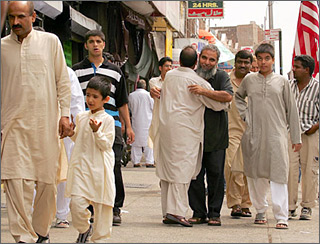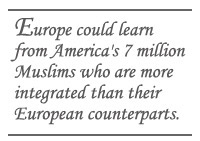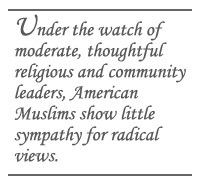Muslims and the Tale of Two Continents
Muslims and the Tale of Two Continents

BRUSSELS: Muslims in Europe are once again in the spotlight – this time because of German police foiling a terrorist plot hours after Danish authorities arrested Muslim youth for plotting attacks. These also follow a failed plot in June, to explode car bombs in central London and Glasgow International Airport. The botched attacks, following the terrorist scare at British airports in summer 2006 and suicide attacks on London's transport system in 2005, prompted British Prime Minister Gordon Brown to promise tighter border controls and resurrect controversial proposals to extend pre-charge detention times for terrorism suspects.
Significantly, Brown also promised to eradicate extremism among increasingly alienated young British Muslims, an initiative that echoes wider-ranging European Union efforts to counter violent radicalization of young Muslims across the 27-nation bloc.

Brown and other EU leaders face a tough task. While most of Europe's estimated 20 million Muslims are fully integrated, law-abiding citizens with little sympathy for radical views, others are frustrated with government policies that keep them on the fringes of the mainstream. Originally from poor, rural backgrounds, a high proportion of Europe's Muslims came to the continent to labor in coal mines and steel mills during the 1960s and 1970s and remained at the bottom of the economic pile, ignored by politicians and business leaders while facing discrimination in housing, schools and labor markets.
European governments' failure to tackle these problems, combined with tough counter-terror measures and the rise of xenophobic parties, have heightened the sense of alienation felt by many Muslims in Europe. Muslims' search for refuge in conservative Islamic values has prompted friction with Europe's traditional secular liberalism and, in some cases aided by foreign-trained radical imams, created fertile ground for the spread of extremism in Islamic communities.
Europe's predicament causes concern across the Atlantic. Many US policymakers accuse EU governments of ignoring the security implications of young Muslims' radicalization and suggest that Europe could learn from America's 7 million Muslims who, measured by educational and income levels, are far more integrated than their European counterparts.
Muslim communities in the US and Europe certainly share some similarities, and a transatlantic dialogue would be useful in promoting best practices on integration. However, American and European Muslims face different challenges, reflecting their distinct composition, history and experience.

After the devastating 9/11 terror attacks in 2001, Muslims in both the US and Europe fell under close scrutiny, a condition that binds the two communities together. Muslims on both sides of the Atlantic tackle hard-line policies of suspicious governments, combat public prejudice and counter criticism of their faith as repressive and cruel. This in turn has prompted an eagerness among Muslims in both the US and Europe to assert their "Islamic identity." Despite pressures to conform to Western appearance and values, women in both communities increasingly wear headscarves, and a growing number of young adults attend mosques. In addition, US policy in the Middle East is a constant, painful irritant for Muslims of both continents.
Despite their common struggle against prejudice, however, US and European Muslims live in two markedly different worlds, largely because of income. Most American Muslims are well-educated, affluent and politically active. “They are better off than the average US citizen,” notes Philippa Strum of the Woodrow Wilson International Center for Scholars in Washington. Almost 60 percent are college educated, 52 percent have an income of $50,000 or more and 82 percent of those eligible say they are registered to vote. In contrast, “Muslims in Europe belong to the underclass of Europe,” says Jocelyn Cesari, an expert on Islam in Europe.
Savvy American Muslims are way ahead of their European co-religionists in terms of social standing and political clout. More active as a community, they have access to enlightened leaders and engaged in energetic, often heated debate on reconciling Islam and modern America. As a result, they’re better equipped to fight discrimination and gain respect as a minority.

America's tradition of embracing immigrants has made it easier for the diverse Muslim community – including Arabs, South Asians as well as white and African-American converts – to become part of a vast melting pot of religions, cultures and ethnic groups. Europe's small, culturally homogenous nations still find it difficult to extend a warm welcome to immigrants who, for their part, tend to retain native languages and customs, clustering in small enclaves with compatriots.
Respect for minorities is just climbing up the EU's political agenda. The German government for decades treated its 3 million Turkish population as “guest workers” requiring no special attention and expected to return home. When disaffected young African and Arab youths in France took to the streets in the “banlieues” of Paris in summer 2005 to protest unemployment and discrimination, President Nicolas Sarkozy, then the country's interior minister, denounced them as “racaille,” or “scum.” A limited outcry met his comments. Anti-immigrant rhetoric is also the norm in once-tolerant Dutch and Danish societies.
For many Muslims, practicing their faith is easier in the US than in Europe. More religious than mainly secular Europeans, Americans are less uneasy about public displays of faith and religious symbols like headscarves, banned in French state
schools and some German regional government offices. The debate over the role of women in Islam raging among US Muslims – with some women fighting segregation in mosques and using faith-based arguments to reclaim women's rights – has yet to reach Europe.
While starting to group together on a national level, Muslims in Europe have yet to forge an EU-wide alliance to match the clout of pan-American organizations such as the Islamic Society of North America, headed by Canadian-born Ingrid Mattson, or the Council on American-Islamic Relations. American Muslims may feel targeted by the October 2001 Patriot Act, which increased power of law-enforcement agencies to fight terrorism, but organizations lobbying for Muslims and other professional and civil-liberties groups ensure that Muslims have no need to withdraw from the mainstream.

Most significantly, under the watch of moderate, thoughtful religious and community leaders, American Muslims show little sympathy for radical views. In contrast, European security services have identified mosques as central in the spread of radical Islamist ideologies and the recruitment of homegrown and foreign-born terrorists in Britain, France and the Netherlands. One problem is that EU governments have traditionally allowed Saudi Arabia and other conservative governments to fund mosques and imams in Europe, and evidence suggests that Al Qaeda recruiters infiltrated some mosques. As highlighted by a recent BBC survey, a majority of imams in Britain, from India, Bangladesh and Pakistan possess limited English and fail to provide a modern interpretation of the faith suited to a Western multicultural democracy.
Given such divides, EU policymakers and European Muslims often insist they can learn little from the US experience. Certainly, America's tradition as an immigrant melting pot cannot be transposed to Europe. As evidenced by heated EU debate on membership of mainly Muslim Turkey, most Europeans are also unlikely to lose their chronic fear of Islam.
But to avoid further alienation and violence, EU governments and Muslims in Europe must step off the beaten track and chart a new course for speeding Muslims' integration into the mainstream. This may require discussion of the so-far taboo question of affirmative action for Europe's Muslim minority. More importantly, instead of turning to Arab and other Islamic nations to discuss European Muslims, EU governments should examine how the US government, society and business tackle the challenge.
Shada Islam is a senior program executive at the European Policy Centre. She writes for YaleGlobal Online in a personal capacity.